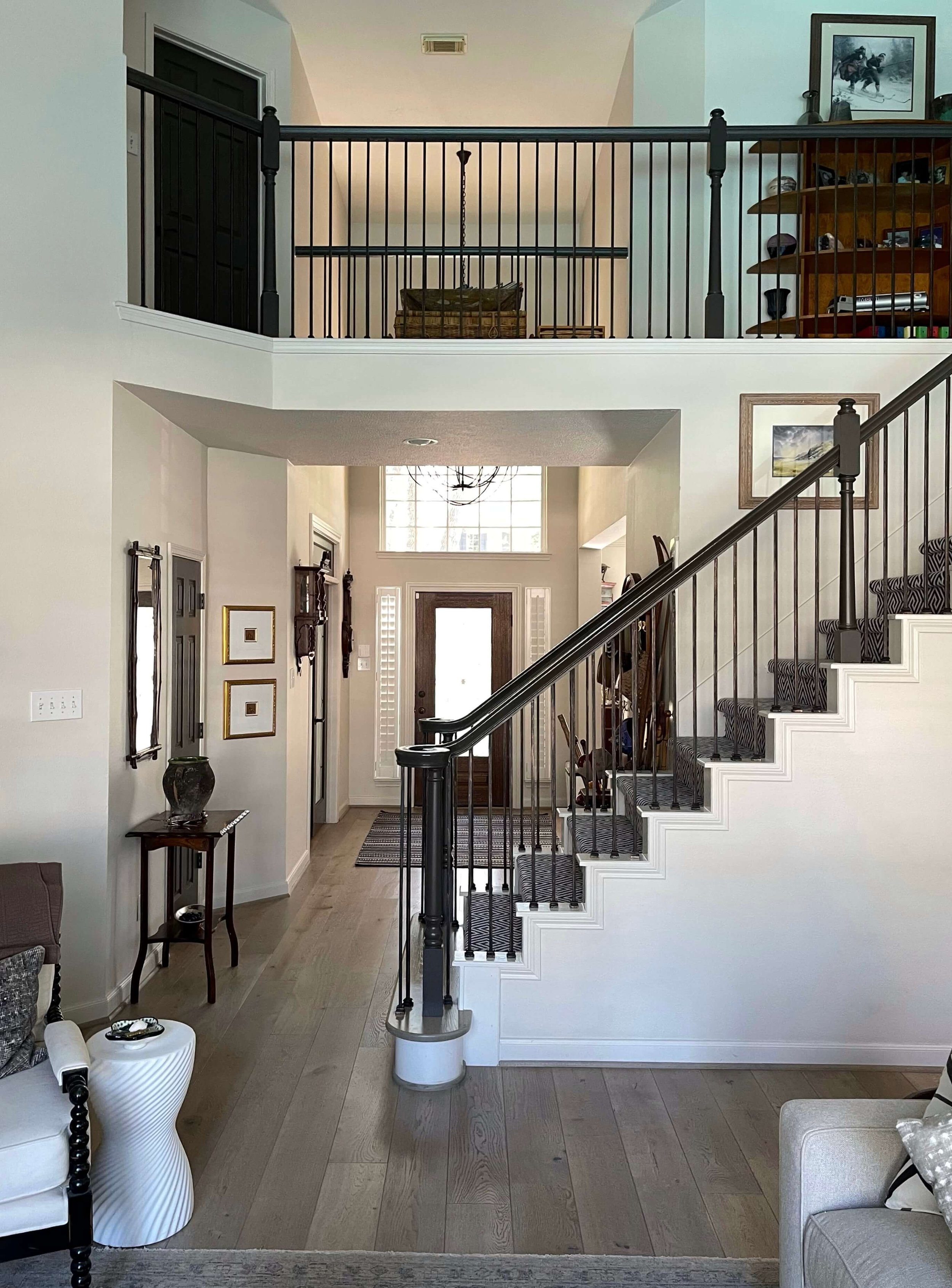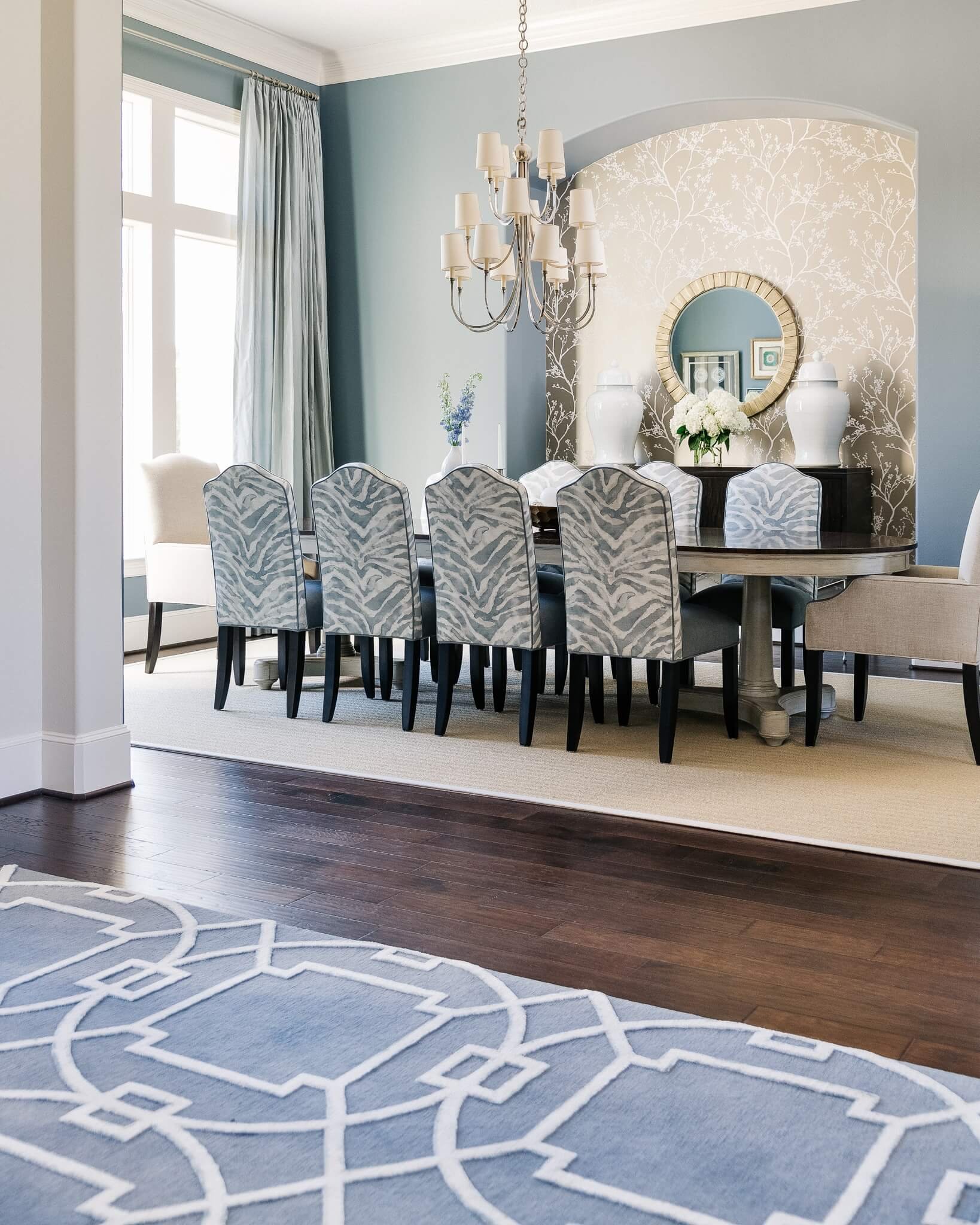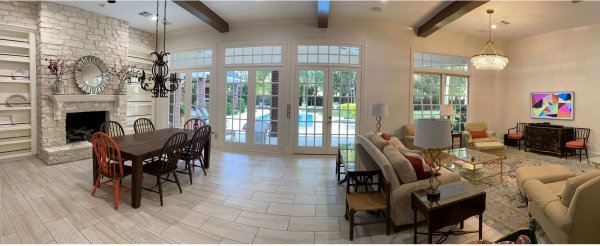Do you have an open floor plan house that is all one color (usually white, beige or gray) but you love color and want to infuse it into your home without painting the whole house?
Well, I have 9 ways to hit your space with color so that you won’t feel like you are living without it any more.
The problem is, typically, people want to paint the walls but there is often not a convenient or easy-to-pinpoint place to stop and start the color with an open floor plan house.
For example, in my home, my living walls are all open and flow into the entry hall, kitchen and upstairs spaces. If I painted the walls, I’d be painting 24’ high walls bleeding into all the other open areas of my house.
I totally understand this problem.
This is my house, pictured below. See how the living room space (the one I’m standing in) is open to the entry, the hallway upstairs and it is open to the kitchen.
Many suburban homes have this problem, the space is all open so it is difficult to figure out where wall color can stop and start in the open areas. carlaaston.com
Let’s get started with some solutions.
1) Window Treatments
Window treatments like drapery panels, can add significant color in a room and make a big impact. It’s almost like painting a wall, but you’re doing it with fabric.
The draperies in this dining room, designed by Linda Eyles Design, from the ASID Showhouse 2019, make a big color statement in a space with neutral walls.
ASID Showhouse - Dining Room designed by Linda Eyles Design.
This green drapery makes a bold statement in a Highpoint Market showroom with all neutral walls.
Velvet curtains hung at a niche add drama and richness to this simple space in a High Point Market showroom.
2) Enclosed Rooms off the open plan area
Rooms that are more enclosed and separate (but highly visible), from the major open plan area, are great places to paint the walls to add color.
This dining room is separate from the entry and open area of the home but has a wide main opening, like you see below, and is very visible when you enter the home.
This color makes an impact on the overall look of the home. It is much easier to find a place to stop and start the color in here.
Blue dining room off the entry hall of an open floor plan home. Designer: Carla Aston, Photo: Colleen Scott
3) Insert color within mouldings or trim
This dining room was open to the stair on one side and the entry hall on the other. It was not an enclosed room, more like an alcove. To get some warmth and contrast into this space, we added trim moulding on the back wall with a grasscloth wallcovering inside the box that was created.
Areas within moulding trim applied to walls can be a place to contrast your paint color and limit having to paint everything in the room. Designer: Carla Aston, Photo: Colleen Scott
I thought this was clever in a showroom at Highpoint Market, they wrapped fabric around framing and hung on the wall. This could work well in a rental situation. It’s rather a paneled look.
Upholstered panels make for an interesting way to bring color to an open floor plan space.
These framed fabric panels have the same effect as wallpaper installed in moulding boxed shapes.
4) Cabinetry
Whether you paint just the inside backs of your cabinets or all of them, adding color just to the built-ins can be a very effective way to get a substantial hit of color.
These built-ins beside a fireplace in a family room were painted to match the kitchen island, also in the big, open space. Designer: Carla Aston, Photo: Colleen Scott
Mud room cabinetry looks great in a contrasting color, something other than white, seen in this model home.
This blue built-in bookshelves help wrap the room in a soothing color. Seen at the Greensboro Junior League Showhouse, Designer: Vivid Interiors.
5) Accent Walls or partial painting
If you have one wall that is a solid wall, without doors or openings, that has visible ending edges, then that is a good place to add an accent color.
An accent wall like this green one in a home office situation makes a great place to add just one wall of color without having to paint everything.
I also like the idea of painting a design or doing color partially on the wall, not over the entire room.
Den in a model home with a painted wainscot.
This fireplace section was painted a bold red in a showroom at Highpoint Market. Designer of this space, Shannon Ggem.
6) Interior Doors
Doors, whether you choose all the doors in your home or only choose a few, is a good place to inject color into a house. Especially with specialty doors that don’t necessarily have to match the rest of the doors in the home.
Pantry doors, barn doors, special sliders, etc. can easily be a bolder color so that they stand out and make a statement in the space.
A pantry door brings some color to this white kitchen. Designer: Carla Aston, Photo: Colleen Scott
The oversized barn door brings the kitchen color over to the mudroom area in this all white-walled, open plan home. Designer: Carla Aston, Photo: Colleen Scott
7) Ceilings
Addressing the ceiling only can be one way to add color to an all neutral space.
A blue ceiling that matches the trim really sets off the scenic wallpaper in this dining room in the Greensboro Junior League Showhouse. Designer: Design by Tula
We put some texture and warm color on the ceiling of this small hallway that went from the entry back to the family room.
A textural warm toned wallcovering helped add warmth to this hallway. Designer: Carla Aston, Photo: Colleen Scott
This room’s ceiling was painted a bold blue with the walls all a shade of white, seen in the Aspire Showhouse, High Point, NC, Designer Meg Caswell.
A bold blue ceiling in this room with white walls creates an interesting use of color. Designer, Meg Caswell | Aspire Showhouse, High Point, NC
8) Furnishings
Furniture in rich, bold hues can add so much to an interior with an all white or neutral walls.
Even items like pillows, lamps and accessories in bold color can introduce enough color into a space to make it feel colorful.
I’ve done a lot of blue sofas in past 5 years or so, it was a popular color that most of my clients wanted. Bold colored upholstery does a lot to add some punch to a home.
Colorful furnishings can add life to a light neutral home. Designer: Carla Aston, Photo: Colleen Scott
This upstairs loft that functions as a children’s lounge area is made more fun with the brightly colored furnishings, like upholstery, rugs and pillows.
It is a space that is open to the entry hall and stair, so wall color was not an option.
Children’s loft space with brighter colors on the furnishings in an all white envelope that is open to the entry and stair. Designer: Carla Aston
Bold coral makes a statement in this living room vignette in a showroom at High Point Market.
Green upholstery adds lots of life in this white room with neutral sisal on the floor in a showroom at High Point Market.
9) Use Several ways To Infuse Color
You don’t have to use only one way to add color into an open floor plan home, you can use several at once.
See these examples below.
This model home showcased a blue accent color with draperies, a rug and art.
I worked on a consultation with someone who wanted to add some color to her great room awhile back. I picked up on the coral color she had and introduced that in other ways in this room.
I offered up some ways to add color with a quick overlay of marker to the photo of her space.
BEFORE - Great room needing some color and layering.
A quick overlay of marker color on the photo of this room shows where color can be added to liven up this great room with drapery and furnishings.
See MORE on this topic, below!
This blogpost was thoughtfully written by me, Carla Aston, and not by AI, ghostwriters, or guest posters.































Adding mouldings is a popular design solution these days for filling big empty walls. I have done this on projects, recommended it in Q&A’s to people with huge walls and have a project now where we are including these as well.
Come and see these examples and a few recent job site photos.